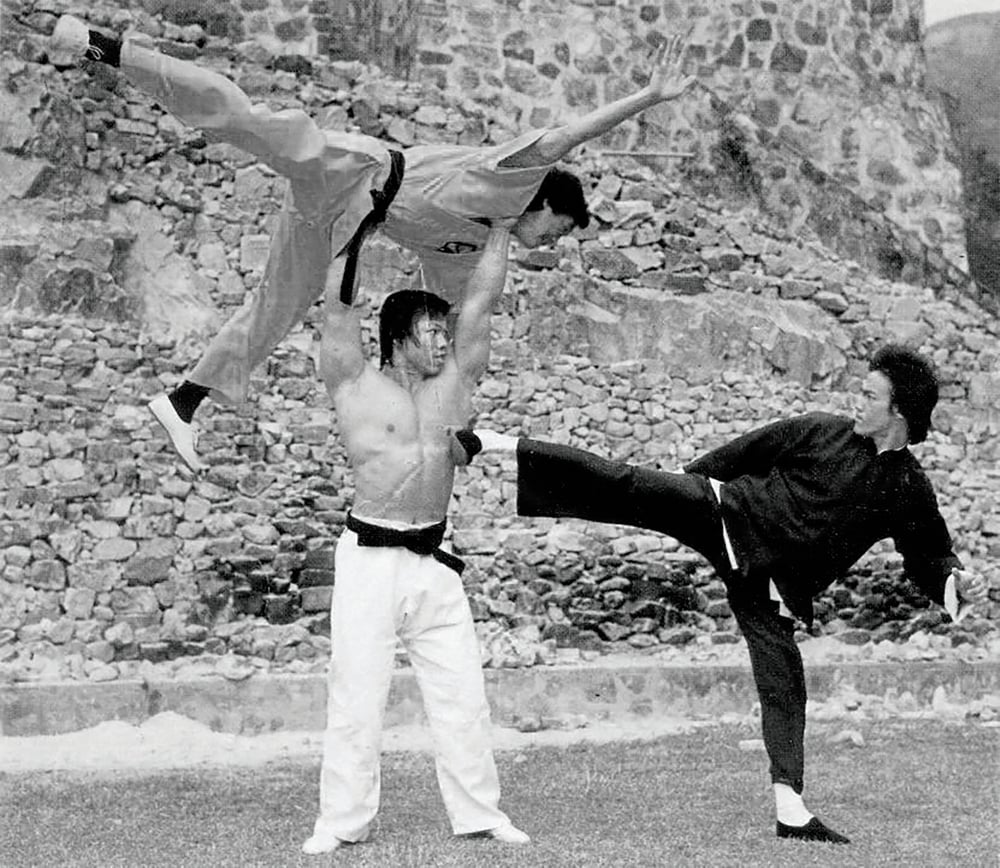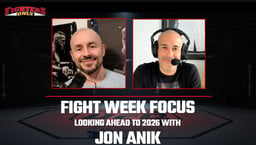
Issue 169
August 2018
Bruce Lee passed away 45 years ago having transformed martial arts forever. We look at his influence on MMA and asks how he might have fared in Octagon
The classic opening scene from Enter the Dragon – Bruce Lee sparring full contact with a young Sammo Hung – epitomizes true MMA. This projects exactly what MMA is based on: two competitors attempt to defeat each other by potentially utilising a variety of fighting techniques, including manipulating areas of striking and grappling. Bruce uses strikes (both punches and kicks), takedowns culminating in a lock/hold on the ground. Furthermore, both participants are wearing the fingerless gloves, which became the precursor of UFC, and the underpants/shorts.
The late Bruce Lee had an indelible impact on pop culture. His majestic presence on the big screen and in person captivated everyone’s attention. In his short life he achieved many things that forever preserved his image in the minds of the public.
Decades before the UFC mushroomed into the mainstream, Bruce Lee revolutionized martial arts bringing them to the attention of millions on a global stage. Following the untimely death of the late master, he garnered profound adulation from professional and amateur athletes and fighters, who recognised Lee’s dedication and revolutionary approach to unarmed combat, which changed the way martial arts were perceived in the West.

Many believe Bruce Lee would have been intrigued by MMA. However, he did have criticism of competition fighting and combat sports in that they are watered down versions of real fights because of the implementation of rules. An element of Lee’s legend was that his potential capabilities were somewhat shrouded in mystery.
Although a wider audience was introduced to the ancient arts of the Far East through the medium of Bruce Lee films, a medium Lee utilised to reach the masses, he had a deep-rooted fighting philosophy which centred around realistic combat. The big screen was merely a conduit to spread his passion for martial arts and achieve his ultimate goal of global dominance. Lee’s onscreen battles were full of flashy moves which didn’t necessarily resonate with real-life self-defence.
Having said this, he incorporated certain elements of realism in his movies, promoting the true philosophy behind his personal art of jeet kune do (the way of the intercepting fist). For example, when he’s fighting Bob Baker (the Russian martial artist, Petrov) in Fist of Fury, Baker traps him in an arm-lock. Lee resorts to dirty street fighting tactics by biting his opponent’s leg. Lee’s dynamism and persona on screen was magnetic but his real-life training and approach to combat reflected reality-based scenarios outside the confines of the dojo and ring.
Very few would doubt that Lee was revolutionary in bringing not just the fighting arts into the spotlight in the West, but also in stressing the need for adaptability and a realistic training approach. Among the athletes who have a deep sense of reverence for the late master are UFC and MMA fighters. A new breed of athletes have expressed their great admiration for Lee’s pioneering status. Countless elite UFC fighters openly acknowledge this 135-pounder as their inspiration and the godfather of MMA.

After a lengthy period of research and experimentation, Lee devised a hybrid style of fighting which encapsulated a composite of fighting techniques. He was able to implement a philosophy which reflected realistic training and fighting concepts, and the need for the individual’s personal expression in total combat.
In modern-day martial arts we have seen exponents embracing cross-training. The MMA movement transformed public awareness of martial arts and within a short time, a brand new sport was created; a sport which has been embraced by both the mainstream media and a wider audience, just as boxing has been for decades. With the advent of the UFC a whole new generation of hybrid fighters have risen to prominence.
Today’s fighters use an array of techniques from a wide range of disciplines. In his quest to become the best martial artist in the world, Lee was doing this back in the 60s; he was way ahead of his time. But this made him something of an outcast in the martial arts fraternity.
As he matured and explored different styles through reading, exchanging ideas and working out with some of the best martial arts exponents of his era - most of whom lived on the West Coast - his study led him to grappling. Wally Jay, founder of small circle jiu jitsu and a close friend of Lee’s, says, “Bruce was interested in all martial arts. I found jiu jitsu books in his library at his home in Los Angeles. And he demonstrated judo throws at my school.”
Bruce’s creative and innovative mind broke stereotypes, which allowed us to re-evaluate the fighting disciplines. He was able to carve away the inessentials and implement and absorb what was effective. Lee’s research took him across the board: concepts from Western boxing, wing chun kung fu, kicking from northern styles of kung fu to taekwondo and the intricacies of jiu jitsu, wrestling and judo. Lee’s own research notes indicate the philosophy behind his approach to fighting, “All techniques are to be forgotten and the unconscious is to be left alone to handle the situation. The technique will assert its wonders automatically or spontaneously. To float in totality, to have no technique, is to have all technique.”

To further reinforce a hardcore and aggressive training frame of mind – as can be seen from his copious notes – Lee examined a plethora of boxing and wrestling concepts, exploring way beyond the confines of the Eastern mystical fighting styles which were mostly geared towards looking good but useless in a street encounter. Lee heavily researched boxing and was a great admirer of legendary boxing champions of his era.
“While in college I taught boxing. I have always told my pupils that you sacrifice punching power if you want speed. Bruce’s demonstration of lightning speed blows which still maintained the devastating power of a heavyweight blew up my theory,” remembers Wally Jay.
Although some may have mixed views about Lee’s grappling credibility, Hayward Nishioka, the Pan-American judo champion, and the revered Wally Jay, of small circle jiu jitsu fame and a judo master, have openly commented on the exceptional martial arts abilities and prowess of the late master. Lee had in actual fact picked up various rudimentary throws, takedowns, locks and chokes from these masters. Another judo champion, and at one time the most notorious grappler on the planet, Gene LeBell, also worked out with Lee for a while exchanging ideas.
Bruce was able to assimilate information which led to him incorporating 33 formal grappling moves into his overall framework. “He had one guy called Gama who had a book on Indian wrestling and was a world champion then,” remembered one of Lee’s original students, the late grappling supremo Larry Hartsell. “He was one of the Maharishi’s champion Indian grapplers, huge guy. And they used to fight in dirt pits and Bruce admired that style of wrestling.”
There’s no question that, although Lee never fully unleashed his potential in this area, he would have honed this component of his fighting arsenal to a professional competitive level. I believe it was just a matter of time, and some of the prominent individuals who worked with Lee also share this sentiment. So there’s no doubt that had Lee lived he would not be so ignorant to overlook modern-day techniques. Utilising them to the best of his ability in his quest to have a solid ground game to add to his already exceptional stand-up striking skills would be a necessity. Of course, there was no “proving ground” in his time as we have in modern MMA.

Bruce made the exchange of concepts within the martial arts the norm rather than the exception, and his concept of adaptability paved the way for others who were trapped in their own disillusioned minds. Today we have cross-training, exponents train in kickboxing, boxing and several grappling arts such as wrestling and Brazilian jiu jitsu in pursuit of becoming all-round fighters. This takes the fighter out of his domain and comfort zone and further into an unknown territory.
Parallel to Bruce Lee’s philosophy, MMA fighters today pursue a strenuous regime which involves resistance training and physical conditioning, technical proficiency and strategy. They are able to separate and blend all of the elements in training and in the octagon and ring. Today we have hi-tech equipment and state-of-the- art methods implemented by the modern-day MMA athlete.
We will never know how Bruce Lee would have fared in the Octagon with the best UFC warriors. Would he decimate them in the fashion his legend suggests? Hypothetical match-ups always spark debates. How would Bruce Lee do against Royce Gracie, GSP or Conor McGregor? All of this talk is speculative atbest. “Sure, he would have got himself in that weight class (145 pounds) and done well,” five-time UFC champion Randy Couture admitted when I asked him if the diminutive-looking legend would triumph in the Octagon. “There’s no doubt about it.”
Although countless, respected UFC champions have gone on record praising Bruce Lee, his close friend, personal student and training partner Ted Wong doubts Lee would have competed in the sport.
“As far as no-holds-barred tournaments like the Ultimate Fighting Championship, I don’t think Bruce would enter something like that,” argues Wong. “The UFC still has some limitations to it, even though they refer to it as ultimate fighting. There are still rules that say you can’t do this or that’. But I think as a test of your skills, Bruce would like it.”
To understand Lee, it’s essential to look at what he was trying to achieve. Lee had a penchant for street-effective combat with no rules or regulations of any kind. MMA is one of the toughest sports on the planet, but still bans some of the more vicious street tactics such as biting, groin kicking and eye gouging. Just as Bruce Lee created a rift in the martial arts community in the 60s, the advent of the UFC started a revolution of its own. In a sport where physical and technical prowess seems to be the most visible overriding asset, Lee pursued the integration of the spiritual and mental cultivation and preached this to his students.
Fighting may have evolved even beyond Bruce’s abilities and comprehension, but Lee will be adulated by many in the MMA circles as the pioneer of MMA. And many feel that had he lived, another evolutionary phase would have taken place in his training as he had great respect for grappling and submissions – he researched a composite of arts with furious enthusiasm. Debates will always continue regarding Bruce Lee and MMA. What’s not in doubt is that he left a legacy, started a revolution in martial arts and had an indelible influence on a great number of the top UFC and MMA champions and fighters. Bruce Lee’s legacy will continue to flourish, even though his light was extinguished more than four decades ago.
...









